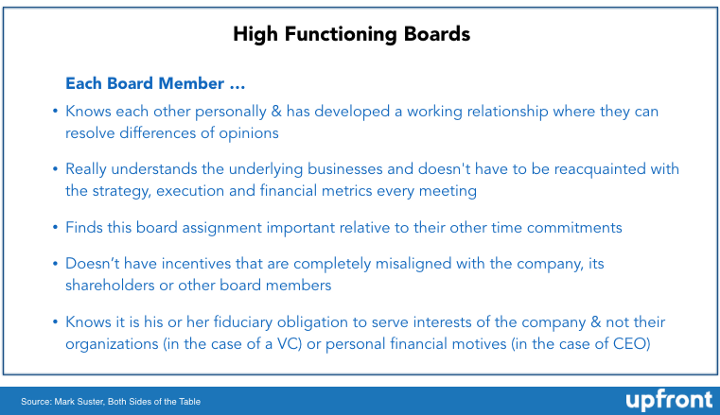
SUMMARY
High-functioning boards have a tight-knit relationship between all members
Low functioning boards are kind of “filibuster” boards
With boards, one needs to be thoughtful about what the company hope to achieve
I’ve sat on many boards over the past 2 decades and seen my share of high-functioning boards and low-functioning boards. Here are some observations I have from this exposure:
If a company moves from strength-to-strength with predictable outcomes, easy financings, low staff turnover, limited competitive threats then the composition of the board probably doesn’t matter as much. Even the best companies with the best outcomes, however, usually hit some difficult moments where a highly-functioning boards matter.
In the best cases, boards come together to help the company get through its trough — in the worst cases, infighting can mean an otherwise great potential business is hampered with in-fighting, misaligned incentives and drama.
High Functioning Startup Boards
High-functioning boards have a tight-knit relationship between all members based on mutual trust and admiration. They are able to divide responsibilities and work to gain consensus on tough decisions that every startup inevitably faces.
It sounds obvious, I know. But you can’t take it for granted that your board members will naturally commit to building meaningful relationships with each other. Your role as a founder who brings on board members should be to understand the importance of the team dynamic and try to foster better human relationships so that in the future when you need people to work together for a common purpose trust and rapport has been formed.
As an investor board member, I see this as my immediate goal, too. I work hard to create working relationships with my fellow non-management board members in the same way that every investor ultimately works to develop strong working relationships with founders.

What are the kinds of difficult tasks that need to be solved by boards?
- What should the cash burn rate of the company be and how long of a cash runway should the company maintain? (this requires a working understanding of the cashflow statements and key levers)
- What should the compensation of key executives in the company be? (this requires a strong knowledge of market data, employee performance, company performance relative to market and available resources — cash & unallocated stock options)
- Should we raise capital, from whom, how much and at what price?
- Should we cut costs, do layoffs, close divisions and focus scare resources on fewer projects?
- The founders of a company are fighting. Can we help them get along? Or is it time for one of them to go? And if so, who should leave and who should stay?
I find that some founders are insecure and hate the idea of his or her board members talking without them present. In fact, last year I was in a board meeting where we asked for time to meet and strategize without the executive team.
We were trying to get aligned around a complicated set of issues and since it had new board members we hadn’t all had time to bond and align ourselves yet. The founder kept coming in and interrupting and showing signs of visual frustrations. I tried to explain to him that it was a healthy thing that we were all speaking.
Part of the way you get high functioning boards is to spend social time together. It isn’t always possible but when it is I recommend that you try to build in casual time for breaking bread or a drink before or after a board meeting as a way of building human bonds that lead to higher functioning boards.
I practice what I preach. Every year I invited my largest investors to NYC to have an LPAC meeting (Limited Partner Advisory Committee — kind of like a board for a VC firm). We do lunch where everybody has a casual conversation followed by 6 hours of content and discussion.
We then do a cocktail party so that everybody can have informal conversations (including LP to LP) and then we do a dinner in a private room at a restaurant. During the dinner I do half of it casual (chit chat with your neighbors) and half of it group “table topics” where we share ideas.
Whenever I’ve faced my toughest moments or biggest decisions as a VC firm, having trust with my LPs and vice versa goes a long way.
Low Functioning Boards
If you’ve been around startup boards for a while you’ve undoubtedly experienced low-functioning boards.
Many of us have sat on boards with fellow board members who don’t seem to read the board materials before the meeting. Much time is wasted during the board meetings teaching this board member remedial information.
Some boards are ineffective because management chooses to treat the board more as a perfunctory “update” rather than truly engage the board in strategic decisions.
Some boards are designed to showcase each and every member of management by having everybody lead a 20-minute update only to find out that no time has been allotted for discussion or debate. I call these “filibuster” boards.
Some board members spend all of their time in the meeting on electronic devices doing email or even checking social media. I’ve seen both quite a bit. Some board meetings all of the members dial in and you can tell aren’t as engaged as they otherwise would be in person.
Sometimes boards are misaligned due to incentives. One board member comes from a small VC fund hoping to exit early while another has written a $50 million check and expects different decisions to be made.
Sometimes boards are ineffective because management doesn’t schedule enough time, meetings don’t happen frequently enough, key issues aren’t debated.
Sometimes boards have members with no skin in the game and no personal responsibility in outcomes. These board members can be cheerleaders for management in good times but avoid the really hard decision in tough times as they get caught between founder & capital disputes.
And of course, there are always the ineffective boards that have too many members, too many +1’s that speak up, too many customers on the board making it hard to discuss difficult issues. In fact, in some of these cases, you even seen shadow boards set up that often meet on different occasions.
Summary: Making Your Board More Effective
Chose the right members. Be thoughtful about their skills and motives. Build personal relationships. Spend the time to make sure they’re updated BEFORE the board meeting. Test how they’re feeling about you, the company, fellow board members — know your politics. Be responsive to any issues.
Make sure the board member to board member relationships are strong and don’t assume it will happen on its own. Be thoughtful about what you hope to achieve.
A high-functioning board comes with active management and you actually have to care about having a high-functioning board. It’s an easy thing to overlook because often you won’t need to rely upon in. But if a crisis ever arises all of the preparation you put in will be invaluable.
[This post by Mark Suster appeared first on bothsidesofthetable and has been reproduced with permission.]


























